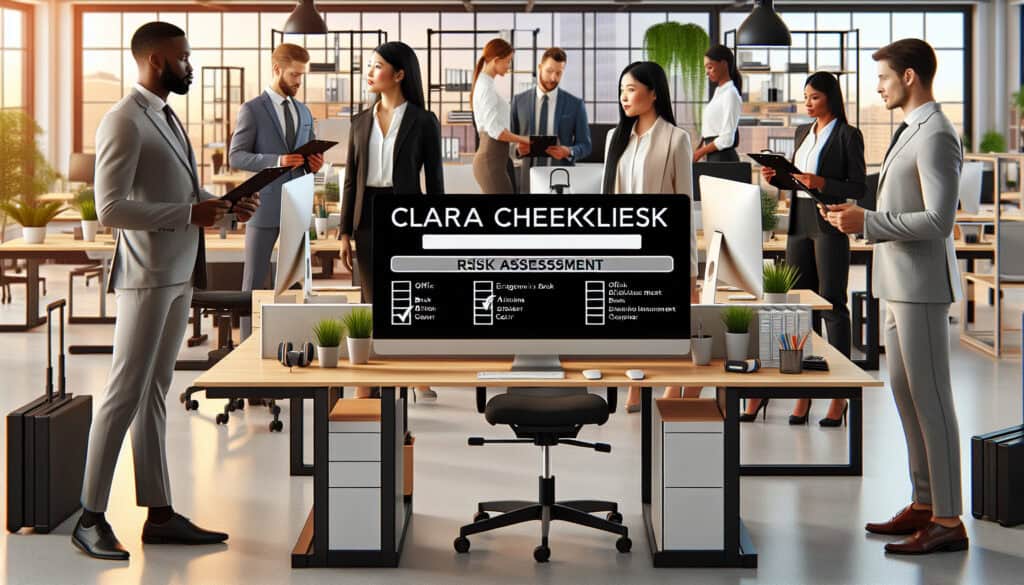A checklist-based tool designed for the rapid initial assessment of مريح risks in the workplace.
- المنهجيات: بيئة العمل
CLaRA (Checklist for Risk Assessment)

CLaRA (Checklist for Risk Assessment)
- التحسين المستمر, بيئة العمل, العوامل البشرية, هندسة العوامل البشرية (HFE), تحسين العمليات, إدارة الجودة, تحليل المخاطر, إدارة المخاطر, أمان
الهدف:
كيفية استخدامه:
- CLaRA provides a structured set of questions to guide an observer through an initial screening of physical, postural, and environmental risks associated with a task, helping to prioritize which jobs need a more detailed assessment.
الايجابيات
- Simple and quick to use, requires minimal ergonomics expertise for initial screening, and helps to systematically identify and prioritize a broad range of risks.
سلبيات
- Acts as a screening tool, not a detailed analysis; may miss complex or nuanced risk factors; risk ratings can be subjective.
الفئات:
- بيئة العمل, الموارد البشرية, إدارة المخاطر
الأفضل لـ
- Performing a quick and simple initial screening of workplace ergonomic risks to prioritize further action.
CLaRA serves as a practical tool widely applicable across various industries where environmental and physical ergonomics are relevant, such as manufacturing, healthcare, and logistics. This methodology can be utilized in early project phases, particularly during initial risk assessments of work tasks to identify potential hazards and ergonomic deficiencies that may lead to workplace injuries or decreased productivity. By involving team members from different departments, such as safety officers, engineers, and ergonomic specialists, organizations can ensure a comprehensive evaluation, facilitating a collaborative approach to problem-solving. In settings where rapid prototyping and iterative design processes are common, CLaRA provides an efficient means to prioritize tasks and allocate resources effectively, as it allows teams to quickly determine which jobs necessitate further exploration before extensive engineering interventions. This structured checklist format resonates well with diverse stakeholders, allowing for engagement without necessitating advanced knowledge of ergonomics, thus making it accessible to a broader audience within an organization. Risk prioritization derived from CLaRA assessments can also inform the development of training programs aimed at improving worker awareness and reducing potential hazards in everyday practices, further contributing to a safer work environment. In alignment with continuous improvement practices, companies may routinely implement CLaRA assessments as part of their health and safety audits or performance reviews to ensure that ergonomic standards adapt to evolving job demands and technologies.
الخطوات الرئيسية لهذه المنهجية
- Identify the task to be assessed and understand the context in which it is performed.
- Analyze the physical demands of the task, including repetitive motions and handling of objects.
- Evaluate postural risks, such as awkward positions that may lead to discomfort or injury.
- Examine the environmental conditions that could contribute to risk, including lighting and workspace layout.
- Prioritize risks based on severity and likelihood of occurrence to determine which require further assessment.
نصائح للمحترفين
- Involve team members in the evaluation process to acquire diverse insights and identify overlooked risks.
- Regularly update the CLaRA checklist with new ergonomic findings or organizational changes to maintain relevance.
- Integrate CLaRA findings with quantitative data from injury reports to create a more robust risk prioritization strategy.
لقراءة عدة منهجيات ومقارنتها, نوصي باستخدام
> مستودع المنهجيات الشامل <
مع أكثر من 400 منهجية أخرى.
نرحب بتعليقاتكم على هذه المنهجية أو المعلومات الإضافية على قسم التعليقات أدناه ↓، وكذلك أي أفكار أو روابط متعلقة بالهندسة.
منشورات ذات صلة
إدارة عمليات التصنيع (MOM)
نظام تنفيذ التصنيع (MES)
خطة مراقبة التصنيع
الاختبار اليدوي
مخططات تقييم المناولة اليدوية (MAC)
أداة تقييم مخاطر المهام اليدوية (ManTRA)